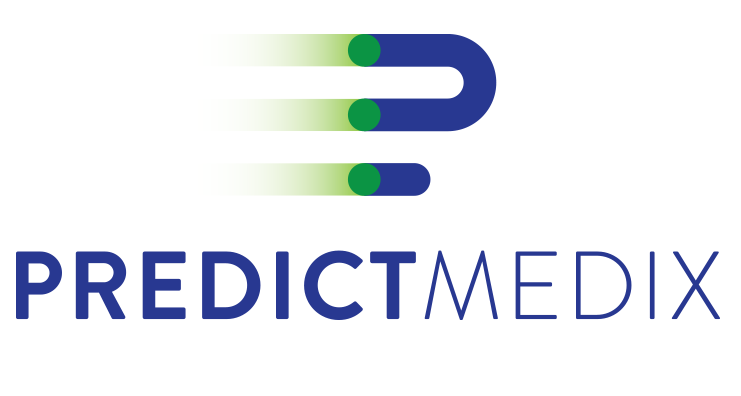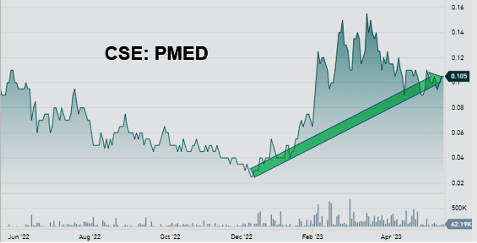Special Report

- Predictmedix (CSE: PMED) (USOTC: PMEDF) (FRA: 3QP) is the latest addition to my buy list and this week I am going to discuss how a company like PMED gets to be a ten-bagger in the market. Just to remind you, PMED is an emerging provider of rapid health screening and remote patient care solutions globally. The Company’s Safe Entry Stations – powered by a proprietary artificial intelligence (AI) – use multispectral cameras to analyze physiological data patterns and predict a variety of health issues including infectious diseases, impairment by drugs or alcohol, fatigue or various mental illnesses. PMED’s proprietary remote patient care platform empowers medical professionals with a suite of AI-powered tools to improve patient health outcomes. PMED’s technology is tested and peer reviewed, it is non-invasive and it is highly scalable.
There are many ways to estimate the attractiveness of an individual security. For the large cap sector, analysts often use the comparison of price versus growth, that is, what price to earnings ratio is an investor paying compared to projected growth? For mature companies, the discounted cash flow method is popular. This is essentially the present value of projected future dividends. Another widely use method is price to book value which basically compares market cap to net asset value of a company.
While all of the above use the comparable approach to some degree, a direct comparative approach is the most appropriate methodology for relative startups, especially in a new or emerging industry. This would apply in the case of Predictmedix (CSE: PMED) (USOTC: PMEDF) (FRA: 3QP), my most recent recommendation to subscribers.
Finding a comparable for PMED on the Artificial Intelligence side is virtually impossible but I did find one in the cannabis breathalyzer category. For the purposes of this report, I will compare PMED to Cannabix Technologies (CSE: BLO) (USOTC: BLOZF) (Frankfurt: BCT). To make it easier for readers, I will compare PMED (Predictmedix) and BLO (Cannabix Tech) below followed by my observations. I have not spoken to BLO management but have taken information from their web page.
- PMED CORORATE OBJECTIVES: Developing Artificial Intelligence (AI) products to improve workplace health & safety, enhance protection in public places and provide tools for medical professionals.
- BLO CORPORATE OBLECTIVES: Developing tools for law enforcement and the workplace to detect THC in breath.
- Ohashi: BLO seems to be trying to extend the alcohol breathalyzer test for THC using chemical detection on a contactless basis. The BLO approach is not focussed on detecting impairment. PMED has a unique approach using multispectral cameras, AI and machine learning to detect impairment in a non-invasive fashion, that is, no blowing into a tube or saliva or blood samples are required.
- PMED’s GENERAL APPROACH: Uses multispectral imaging with AI and machine learning for a non-invasive technology to analyze physiological patterns and identify signs of fatigue, impairment from cannabis & alcohol, infectious diseases and vital physiological parameters. In addition, can be used as a simple diagnostic tool to detect signs of depression, dementia and Alzheimer’s.
- BLO’s GENERAL APPROACH: Attempts to identify what is referred to as a characteristic chemical pattern or “smell-print” to identify THC using machine learning to provide a “yes” “no” result. It is described as microfluidic-based artificial olfaction technology.
- Ohashi: BLO is trying to extend the alcohol breathalyzer test to detect THC (cannabis). This will be very difficult to provide impairment information and in parts of their presentations BLO admits their objective is not to detect impairment. PMED’s cannabis impairment detection technology is the offshoot of their efforts to successfully develop workplace safety and medical tools to assist healthcare people. In my opinion, the risk/reward potential is far greater for PMED.
- PMED’S BUSINESS VERTICALS: Multi-vertical business model including:
- Safe Entry: screening for medical facilities such as ERs.
- Fit for Duty: screening employees such as heavy equipment operators to ensure they are not ill, fatigues or impaired by alcohol or cannabis.
- Mobile Cannabis Screenalyzers: actually a part of the Fit for Duty vertical that provides a completely non-invasive technology for use by law enforcement. This will ultimately be developed as a separate vertical.
- Other: there are several other potential applications.
- BLO’s BUSINESS VERTICALS: BLO’s strategy appears to all end up at roadside THC detection. It appears its different opportunities are not unique verticals but the same vertical in different industry applications.
Ohashi: It seems to me the unique approaches developed by PMED have many different applications in many different markets to solve a variety of issues. This makes the PMED technology worth a full and unique value for each vertical such as health care, worker safety and law enforcement compared to a single value for BLO’s product approach to law enforcement.
- PMED’s CURRENT POSITION: The Safe Entry Technology, including physiological patterns, signs of fatigue, cannabis & alcohol impairment, infectious diseases and vital physiological parameters have been tested in third party, clinical studies conducted by MGM Healthcare, a major hospital group in India and at University of Raharja, a prominent university in Thailand. These studies have been supported by peer-reviewed reports published in medical journals.
- BLO’s CURRRENT POSITION: BLO describes its THC Breath Analyzer as an Advanced prototype.
- Ohashi: to me, BLO’s description of Advanced protype as implying the technology might not work or work well. PMED’s technology has been subjected to clinical testing and is supported by peer reviewed studies. In addition, the initial commercial order for the Safe Entry product was from MGM Healthcare that conducted the studies in India. To me, this is a strong indication that the technology works.
- PMED INTELLECTUAL PROPERTY: Has considerable intellectual property value embedded in their proprietary, Artificial Intelligence, machine learning algorithms used to identify specific targets such fatigue or cannabis impairment. PMED has a portfolio of patents applied for include one issued by the U.S. Patent Office for their AI-machine learning powered technology for the non-invasive detection of alcohol and cannabis impairment.
- BLO’s INTELLECTUAL PROPERTY: FAIMS molecular analysis product has been granted a US patent titled “Cannabis Drug Detection Device.”
- Ohashi: it appears PMED patent is specifically directed to the task at hand: identifying alcohol and cannabis impairment that is a more extensive definition and covers the use of Artificial Intelligence and machine learning. However, I am not a patent lawyer and have little expertise in this area.
- PMED COMMERCIALIZATION: Has received an initial Purchase Order from MGM Healthcare for the Safe Entry.
- BLO COMMERCIALIZATON: appears to be at a pre-commercialization point.
- Ohashi: I believe the initial commercial order from MGM is important but to me it is at least as important that the Purchase Order (PO) was from MGM as this was the hospital group that conducted the clinical testing in India. This PO lends tremendous additional credibility to PMED’s technology.
- PMED MARKET POTENTIAL: the workplace safety market was an estimated $12.8 billion in 2021 and is forecast to more than triple by 2031. The drug screening market is expected to reach $22.24 billion by 2029.
- BLO MARKET POTENTIAL: the global breathalyzer market is expected to grow from $760 million in 2020 to $1.7 billion by 2031 for a compound annual growth rate (CAGR) of approximately 8% per annum. This is significantly less than the workplace safety market growth of 13.5% per annum and the projected growth in drug screening of 16.0% per annum.
- Ohashi: all of these projected growth rates are well above average but the forecasts that relate to PMED’s sectors are considerably higher than those that apply to BLO’s sectors.
- PMED HIGH MARGIN/CAPITAL LIGHT MODEL: PMED’s products are essentially software products that utilize existing AI and machine learning algorithms. The physical content of a Safe Entry Station is expected to be approximately 15% of the initial year of contracted monthly receipts that will decline with volume of production. As a result, it is expected that gross margin will be in the 80% to 90% range and a two month payback indicates that manufacturing capital requirements will not be an issue.
- BLO MARGIN/CAPITAL MODEL: I do not have reliable figures on BLO’s expected manufacturing costs, however, the material suggests their product will be much lower margin because of the use of a chemical identification-type of technology. Such products also do not tend to be capital light.
- Ohashi: the growth rates projected for the underlying industries of both PMED and BLO are strong but PMED’s are stronger. I believe it is easier to swim with a strong tide than a weak tide and that is what PMED will be doing as both companies move ahead from here. Most important, of course, is the success of the underlying technologies and products but industry growth is certainly a positive characteristic.
- APPROXIMATE CURRENT MARKET CAP: On May 12, 2023 according to Yahoo Finance, the market cap for Predictmedix (CSE: PMED) (USOTC: PMEDF) (FRA: 3QP) was approximately $14.1 million. At the same time, the market cap for Cannabix Technologies (CSE: BLO) (USOTC: BLOZF) (Frankfurt: BCT) was around $38.8 million. Here is my comparative analysis:
- BLO is valued by the market 2.8 times higher than PMED.
- my assessment is that PMED’s technology is superior to that of BLO because:
- The technology is in a hospital in India and university in Indonesia.
- The positive test results have been published in peer reviewed reports in medical journals.
- The first commercial sale of the Safe to Enter product has been received from the hospital that was actively involved in the testing which provides additional credibility for the technology.
- PMED’s technology has been clinically tested and supported by peer reviewed studies published in medical journals. Not only that, the initial purchase order that marked the beginning of commercialization of PMED’s technology was received from MGM Healthcare of India that is an important hospital group that conducted the testing. This validates and lends even greater credibility to the technology to a market with over 69,000 hospitals.
- PMED’s proprietary AI technology offers several high growth verticals including Safe Entry Stations (medical/healthcare), Fit to Serve (employee safety), cannabis impairment detecting mobile scanalyzer (law enforcement) and Modilewellbeing Telehealth (remote healthcare).
- As a result, it would be easy to argue that PMED’s market cap should be at least on a par with or higher than BLO’s. That represents nearly a three bagger plus for buyer’s of PMED stock today. But that’s not the whole story.
- PMED’s alcohol and cannabis impairment detection technology is but one leg of at least a three-legged stool with each leg having at least a value equal to or greater than the impairment detection leg which gets us into a ten-bagger range for today’s PMED investor.over
Conclusion: In making such a comparison, it might appear that I am being disrespectful of BLO and their efforts. I am not. But if you make a comparison, one may always come off better than the other. For example, if you compare the Red Bull F1 race car to the Mercedes F1 race car over the last year or so, your conclusion might favour Red Bull over Mercedes. This does not disrespect Mercedes because we shouldn’t forget that the Mercedes F1 car is still better than the other almost all of the F1 cars in each race. As a result, I am not concluding BLO is bad; I am simply concluding that PMED is better. Given the market is giving PMED a valuation or around one-third of BLO’s, I conclude PMED is a raging bargain.
The key reasons for reaching such a conclusion include:
- PMED has a technology that has been proven through clinical trials hospitals supported by peer reviewed studies published in relevant journals.
- PMED’s Safe Entry product is commercialized by a Purchase Order received from a major hospital group in India where there are 69,000 hospitals.
- There is significant commercial potential in PMED’s technology’s ability to detect impairment from alcohol and cannabis.
- PMED is a software company with an Artificial Intelligence, machine learning set of algorithms that provide the targeted diagnostic results. The capital cost of the hardware for each unit has a two month payback. PMED is a capital light business model.
- As a result of the capital light model, the gross margin is expected to be 80% to 90%. This means positive EBITDA and cash flow will be virtually immediate and profitability should be attained in a relatively short period of time.
Given the advantages outlined above and strong evidence of undervaluation in the market, I think it is fair to conclude that:
- If Cannabix Technologies (BLO) is trading at a market cap of approximately $39 million and Predictmedix (PMED) is trading at a market cap of approximately $14 million, then,

- Given unsettled market conditions, PMED has been performing very well. PMED closed a financing in February 2023 and a consolidation period is normal. When the consolidation is concluded, the stock is expected to rally strongly.
- At this point in the market, PMED is grossly undervalued in comparison to BLO.
- Based on my assessment, PMED should trade at a market cap most likely higher than BLO which would be an approximate tripling of PMED’s share price based on what has been reported so far.
- Arguably, PMED should be valued much higher than BLO because of the potential revenue and earnings from PMED’s additional business verticals. I think PMED has the right technology at the right time to capture a dominant position in their commercial markets that are just starting to be recognized. Sectors such as Safe Entry and Fit for Duty.
- I am particularly interested in the application for mobile detection of cannabis impairment which I think has substantial potential.
These are the reasons I am very enthusiastic about Predictmedix (CSE: PMED) (USOTC: PMEDF) (FRA: 3QP) and believe it offers ten-bagger potential at current prices. You should buy a position for your portfolios.
This Report is written by Ted Ohashi, Let’s Toke Business Newsletter.
